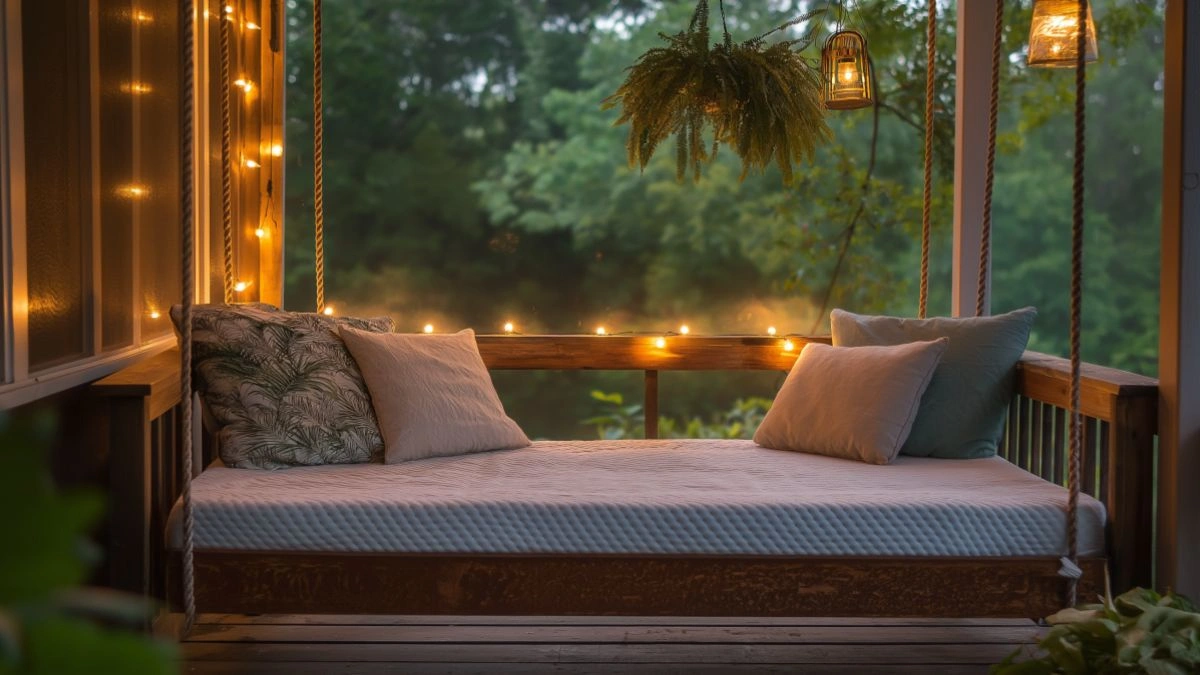How to Build a Comfortable DIY Porch Swing Bed for the Perfect Seasonal Retreat
Table of Contents
There’s something deeply comforting about a porch swing bed—the gentle sway, the fresh breeze, and the cozy, cocoon-like feel that invites you to linger just a little longer. As front porches and backyard nooks continue to gain popularity in seasonal home design, the DIY porch swing bed is emerging as a favorite project for homeowners seeking both function and relaxation.
A well-built porch swing bed combines rustic charm with practical design. It can serve as your go-to spot for afternoon naps, early morning coffee, or quiet evening reads. According to recent trends, searches for outdoor swing beds have increased by 40% in the last two years—proving that comfort-driven, creative porch design is in demand.
This guide will walk you through how to build a comfortable DIY porch swing bed, from selecting the right materials to adding the final cozy touches. Whether you’re a weekend DIYer or trying your hand at your first carpentry project, we’ll help you bring your vision to life while keeping things practical, affordable, and stylish.
Planning Your Porch Swing Bed: Style Meets Structure
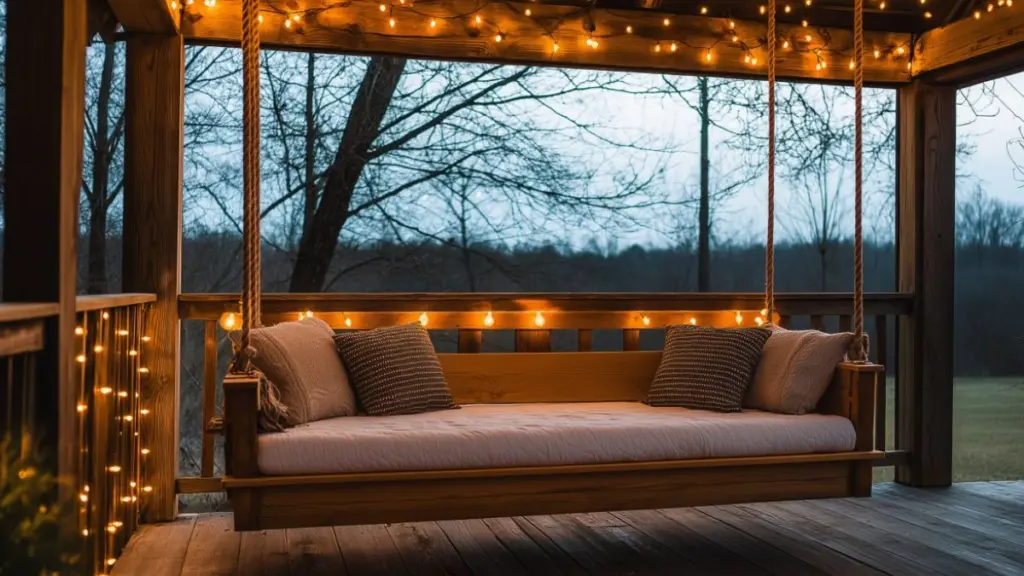
Before you break out the tools, it’s important to plan your project with intention. A successful porch swing bed starts with two things: a clear aesthetic direction and solid support considerations.
Decide on the size that works best for your space. Most porch swing beds are designed to fit a twin-size mattress (39″ x 75″), but you can customize the dimensions for your porch layout. Measure your space carefully, ensuring at least 2 feet of clearance on all sides for safe swinging.
You’ll also want to choose a style. Rustic, farmhouse-inspired frames with natural wood finishes are popular, but modern and minimalist designs with sleek lines work well too. Consider how your swing bed will complement your home’s exterior palette and existing decor.
Planning Considerations Table
| Element | Recommendation |
|---|---|
| Swing Bed Size | Twin (39” x 75”) or custom dimensions |
| Clearance Space | Minimum 24” clearance on all sides |
| Wood Type | Cedar, pine, or pressure-treated lumber |
| Mounting Method | Ceiling joists or porch beams |
| Weight Limit | 500–800 lbs with heavy-duty hardware |
Materials and Tools You’ll Need for the Build
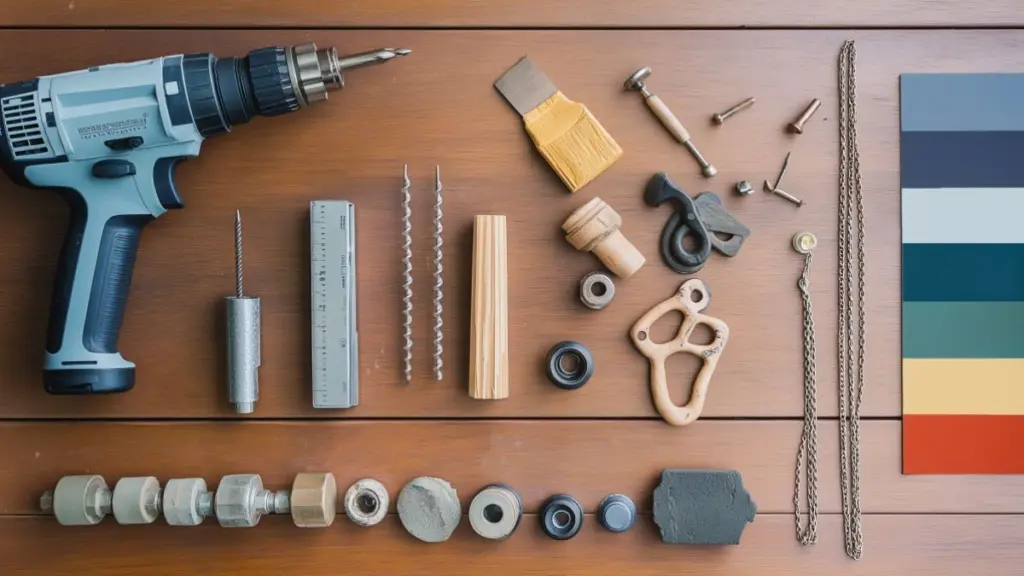
Gathering the right tools and materials before you start will make the build smoother and more enjoyable. Most porch swing bed builds can be completed with basic carpentry tools and readily available lumber.
When choosing wood, opt for durability. Cedar and redwood resist rot naturally, while pressure-treated pine is more budget-friendly. Don’t forget to account for rope or chain, and always invest in heavy-duty hardware to ensure safety.
DIY Porch Swing Bed Supplies Checklist
| Category | Items Needed |
|---|---|
| Wood (for frame) | 2x4s, 2x6s, 1×4 slats |
| Fasteners | Wood screws, lag bolts, eye bolts |
| Hanging Hardware | Chain or rope, heavy-duty swing hangers |
| Tools | Drill, saw, sander, measuring tape, level |
| Finishing Materials | Outdoor paint/stain, weather sealant |
| Accessories | Mattress, outdoor cushions, throw blankets |
Step-by-Step Instructions to Build the Frame
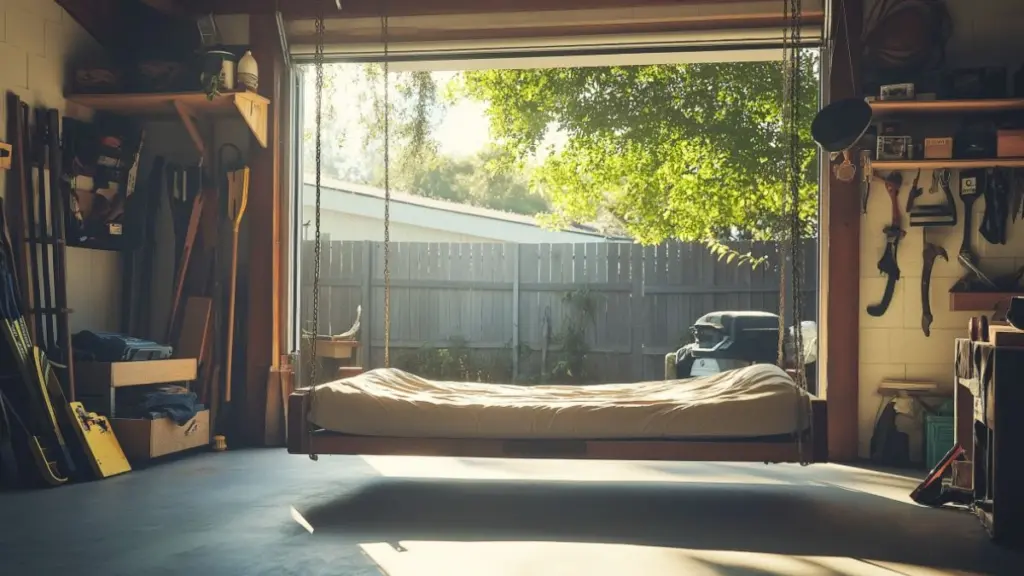
With materials in hand, it’s time to build your swing bed frame. The structure should be strong enough to support the weight of the mattress, pillows, and at least two adults. Below is a simplified guide, but you can modify it based on your style preferences.
1. Build the Bed Base
Assemble the outer frame using 2×6 boards, attaching them with wood screws. Secure support boards underneath to create a platform, then space 1×4 slats evenly across the top to hold the mattress.
2. Add Side and Back Supports
For safety and style, add vertical 2×4 posts to the corners and connect them with horizontal boards. These can be full height for a daybed look or minimal for an open frame design.
3. Sand and Finish
Use a sander to smooth out any rough edges, then apply your chosen paint or stain. Be sure to use weather-resistant products, especially if your porch is not fully covered.
4. Attach Hanging Hardware
Drill pilot holes into each corner and install eye bolts. Measure your porch ceiling and install swing hangers into sturdy beams, then attach your chains or ropes.
Build Process Overview
| Step | Description |
|---|---|
| Frame Assembly | 2×6 base and support slats |
| Side/Back Rails | Adds safety and visual appeal |
| Finish | Sand smooth, apply paint or stain |
| Hanging Setup | Secure swing hardware into ceiling joists |
Choosing the Right Mattress an Cushions for Comfort
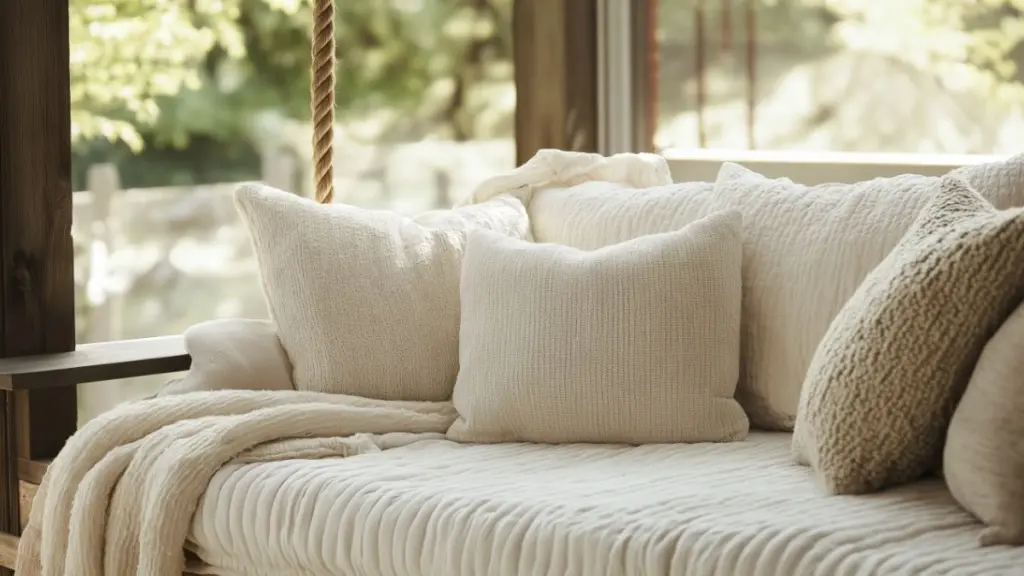
One of the best parts of building a porch swing bed is customizing the comfort. The right mattress and accessories will transform your frame into a space you never want to leave.
Start with a standard twin mattress or a custom-cut outdoor foam cushion. While traditional mattresses can work under a covered porch, they should be wrapped in waterproof or removable covers. Outdoor-specific mattress pads are ideal because they resist mildew and are easier to clean.
Layer your mattress with fitted sheets, outdoor-rated throw pillows, and a cozy blanket for chilly evenings. Mix sizes and textures—use a combination of square pillows, lumbar supports, and round bolsters. Color-wise, go for calming neutrals or soft seasonal tones that enhance the surrounding space.
Mattress & Comfort Guide
| Element | Recommendations |
|---|---|
| Mattress | Twin or custom outdoor cushion (4–6” thick) |
| Fabric Cover | Water-resistant, removable, washable |
| Pillows | Mix of outdoor-rated throw pillows in soft hues |
| Blankets | Lightweight throw for summer, knit for fall |
Hanging and Safety Tips for Long-Term Use
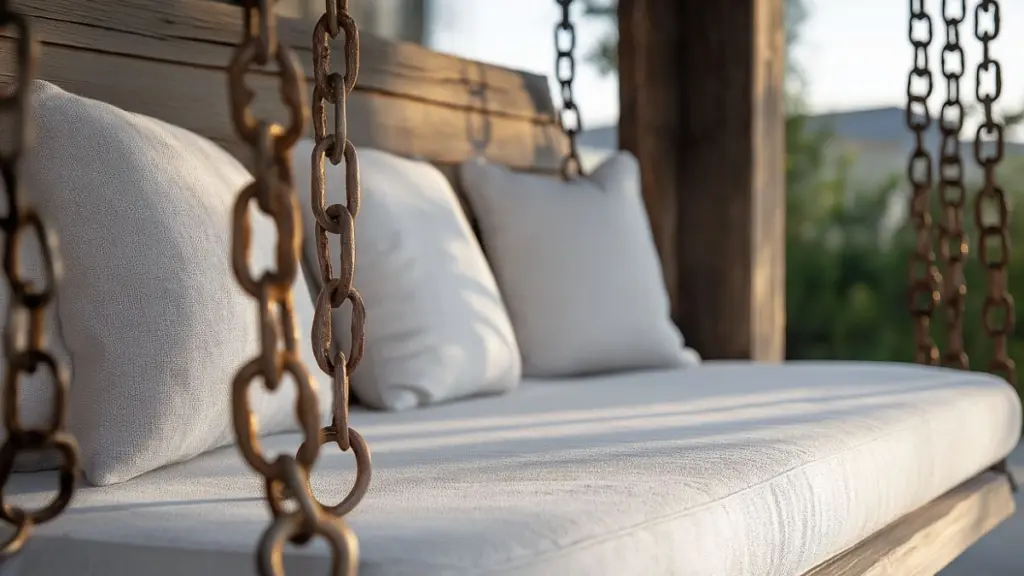
Safety is essential when hanging a swing bed—especially when it’s supporting a mattress and multiple people. The key is to install it into strong overhead supports and use high-quality hanging hardware.
Inspect your porch ceiling to locate structural beams or joists. Never hang your swing from just the ceiling panels. Use a stud finder or consult a contractor if unsure. Drill pilot holes and install lag screws or swing hangers rated for 800 lbs or more.
Choose between chain and rope depending on your style. Chain is durable and industrial-chic, while marine-grade rope gives a relaxed, beachy vibe. Whichever you choose, check regularly for fraying or rust and re-tighten bolts seasonally.
Safety Essentials Table
| Component | Tip |
|---|---|
| Ceiling Anchors | Use joists or beams—never drywall or paneling |
| Hanging Hardware | Choose rated swing hangers or lag bolts |
| Rope/Chain | Use marine-grade rope or galvanized chain |
| Regular Maintenance | Check tension and wear every 3–6 months |
Styling Your Swing Bed for Seasonal Vibes
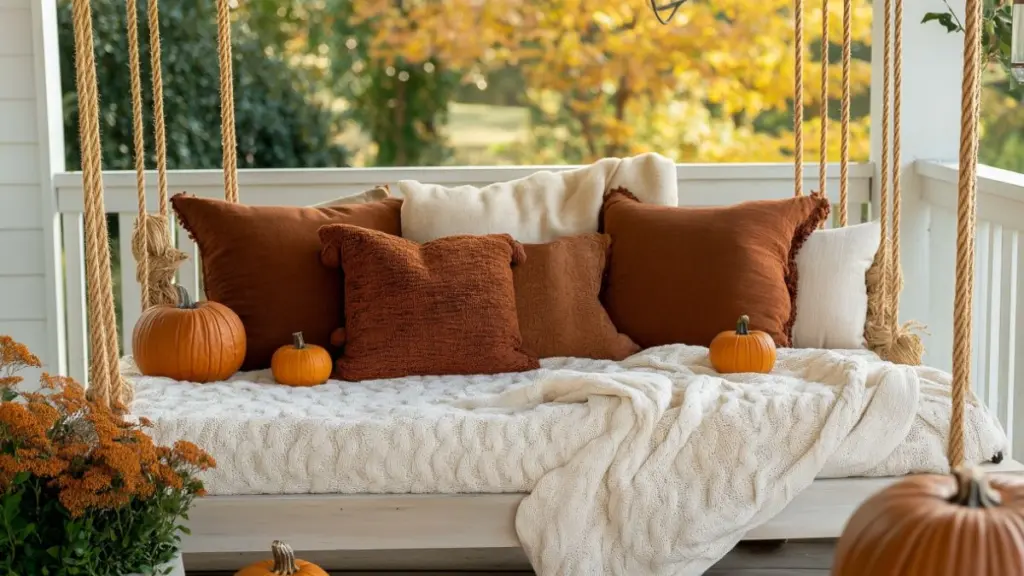
A swing bed offers endless styling opportunities, especially when it comes to reflecting the seasons. You can swap out textiles, colors, and small accents to keep your porch looking fresh year-round.
In spring and summer, go for breathable fabrics, floral prints, and pastel colors. Add potted plants nearby and hang string lights for a soft glow at dusk. In fall, layer in richer tones like mustard, rust, or deep olive with textured blankets and chunky pillows.
Don’t forget practical accents: a side table for drinks and books, woven baskets for throw storage, or a lantern filled with battery-operated candles.
Seasonal Styling Guide
| Season | Colors & Textures | Accessory Ideas |
|---|---|---|
| Spring | Pastels, cotton, floral prints | Potted tulips, rattan trays |
| Summer | Whites, stripes, gauzy fabrics | String lights, citronella candles |
| Fall | Earth tones, knits, flannel throws | Pumpkins, lanterns, plaid pillows |
| Winter | Neutrals, faux fur, fleece blankets | Pine garlands, warm wood tones |
Conclusion
Building your own DIY porch swing bed is more than a weekend project—it’s an investment in creating a restful, meaningful space that welcomes every season with comfort and charm. With the right materials, a sturdy design, and thoughtful styling, you can transform your porch into a serene retreat that reflects your personality and soothes the soul.
Whether you’re reading beneath twinkle lights in summer or wrapped in a wool throw come fall, your handmade swing bed will be the coziest seat in the house—season after season.

